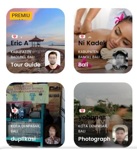Rancang Bangun Aplikasi Mobile Travel-Link untuk Penyedia Jasa dan Seni Pendukung Pariwisata
Abstract
This Travel-Link Mobile Application for Tourism Supporting Services and Arts is software that provides information services for tourists who are looking for service and art providers in the user's tourist destination. This application is designed as a forum for users to promote their services and arts and also users can search for service and art workers, especially in the tourism sector. To ensure that the designed application is suitable for use by end users, interface testing is carried out using the SUS (System Usability Scale) testing instrument. The results of testing the Travel-Link Mobile Application for Service Providers and Arts using the SUS test instrument showed a score of 71. With a score of 71, it can be stated that the Mobile Travel-Link application for Tourism Supporting Services and Arts is acceptable and can be a tool for people who provide services and arts in the tourism sector or are looking for service and art providers in tourist destinations. The addition of the category of service providers and tourism supporting arts can increase the value of respondents when filling out the SUS According to the questionnaire for non-tourism workers.
Downloads
References
[2] R. E. Baldwin, B. Weder, and Centre for Economic Policy Research (Great Britain), Economics in the time of COVID-19. CEPR Press, 2020.
[3] D. Stisip and Y. Tangerang, “PEKERJA LEPAS (FREELANCER) DALAM DUNIA BISNIS MUSTOFA,” Mustofa J. Mozaik, vol. 1, 2018.
[4] H. Yoza Putra and S. Afnarius, “PERANCANGAN APLIKASI WEB DAN MOBILE GIS PARIWISATA SUMATERA BARAT,” 2016.
[5] U. Rahmalisa and Y. Yulanda, “RANCANG BANGUN APLIKASI PARIWISATA BENGKALIS BERBASIS ANDROID MENGGUNAKAN METODE EXTREME PROGRAMMING,” J. Ilmu Komput., vol. 9, no. 2, pp. 98–101, Oct. 2020, doi: 10.33060/JIK/2020/Vol9.Iss2.172.
[6] R. Putra Agrarian, A. Suprayogi, and B. Darmo Yuwono, “PEMBUATAN APLIKASI MOBILE GIS BERBASIS ANDROID UNTUK INFORMASI PARIWISATA DI KABUPATEN GUNUNGKIDUL,” 2015.
[7] K. Darmaastawan, P. Lanang Bagus Suputra Jaya Amertha, and L. Jasa, “Sistem Pakar Diagnosis Penyakit Gigi dengan Metode Breadth First Search berbasis Instant Messaging LINE Messenger,” Maj. Ilm. Teknol. Elektro, vol. 20, no. 1, p. 139, Mar. 2021, doi: 10.24843/mite.2021.v20i01.p16.
[8] N. N. Dananjaya, I. B. G. Manuaba, and L. Linawati, “Rancang Bangun Aplikasi Mobile QR Code Untuk Validasi Pajak Reklame,” Maj. Ilm. Teknol. Elektro, vol. 20, no. 1, p. 131, Mar. 2021, doi: 10.24843/mite.2021.v20i01.p15.
[9] A. Nurhindarto, D. R. Santoso, and E. Y. Hidayat, “Rancang Bangun Aplikasi Sistem Informasi Geografis Objek Wisata dan Kuliner di Kabupaten Kudus Berbasis Smartphone Android,” JOINS (Journal Inf. Syst., vol. 5, no. 2, pp. 288–299, Dec. 2020, doi: 10.33633/joins.v5i2.4297.
[10] N. M. A. Belinda, Linawati, and K. O. Saputra, “UI/UX Design of Educational Game for Earthquake Mitigation,” in Proceedings of 2020 IEEE International Women in Engineering (WIE) Conference on Electrical and Computer Engineering, WIECON-ECE 2020, Dec. 2020, pp. 70–73. doi: 10.1109/WIECON-ECE52138.2020.9398019.
[11] A. Ardianto and A. E. Budianto, “RANCANG BANGUN APLIKASI PARIWISATA MALANG BERBASIS ANDROID.” [Online]. Available: http://developer.android.com
[12] U. Ependi, T. B. Kurniawan, and F. Panjaitan, “SYSTEM USABILITY SCALE VS HEURISTIC EVALUATION: A REVIEW,” Simetris J. Tek. Mesin, Elektro dan Ilmu Komput., vol. 10, no. 1, pp. 65–74, Apr. 2019, doi: 10.24176/simet.v10i1.2725.
[13] A. Irma Purnamasari and A. Setiawan, “Evaluasi Usability Pada Aplikasi Pembelajaran Tari Menggunakan System Usability Scale (SUS),” J. ICT Inf. Commun. Technol., vol. 20, pp. 70–75, 2019.
[14] M. R. Drew, B. Falcone, and W. L. Baccus, “What does the system usability scale (SUS) measure?: Validation using think aloud verbalization and behavioral metrics,” in Lecture Notes in Computer Science (including subseries Lecture Notes in Artificial Intelligence and Lecture Notes in Bioinformatics), 2018, vol. 10918 LNCS, pp. 356–366. doi: 10.1007/978-3-319-91797-9_25.
[15] I. K. Putri, S. Hadi Wijoyo, and Y. T. Mursityo, “Analisis Usability dan Pengalaman Pengguna Pada Aplikasi pemesanan Budget Hotel Menggunakan User Experience questionnaire (UEQ) (Studi Kasus Pada Airy Rooms),” 2019. [Online]. Available: http://j-ptiik.ub.ac.id
[16] S. Suyanto and U. Ependi, “Pengujian Usability dengan Teknik System Usability Scale pada Test Engine Try Out Sertifikasi,” MATRIK J. Manajemen, Tek. Inform. dan Rekayasa Komput., vol. 19, no. 1, pp. 62–69, Nov. 2019, doi: 10.30812/matrik.v19i1.503.
[17] I. G. A. M. Y. Mahaputra, I. G. A. P. R. Agung, and L. Jasa, “Rancang Bangun Sistem Keamanan Sepeda Motor Dengan GPS Tracker Berbasis Mikrokontroler dan Aplikasi Android,” Maj. Ilm. Teknol. Elektro, vol. 18, no. 3, p. 361, Dec. 2019, doi: 10.24843/mite.2019.v18i03.p09.
[18] M. Ulfa, “Analisis Usability Sistem Komputerisasi Haji Terpadu Palembang Menggunakan Metode System Usability Scale (SUS),” 2021.
[19] S. Kasus et al., “EVALUASI USABILITY TERHADAP SISTEM PROMOSI PARIWISATA BERBASIS ANDROID DAN WEB,” 2019. [Online]. Available: http://ejournal.unib.ac.id/index.php/rekursif/
[20] M. Rahmawita Munzir, D. Iriadi, P. Studi Sistem Informasi, F. H. Sains dan Teknologi UIN Suska Riau Jl Soebrantas KM, and P. Pekanbaru -Riau, “APLIKASI OBJEK WISATA BERBASIS ANDROID DI KOTA PEKANBARU,” J. Ilm. Rekayasa dan Manaj. Sist. Inf., vol. 7, no. 1, pp. 1–10, 2021.


This work is licensed under a Creative Commons Attribution-NonCommercial-NoDerivatives 4.0 International License.

This work is licensed under a Creative Commons Attribution 4.0 International License




